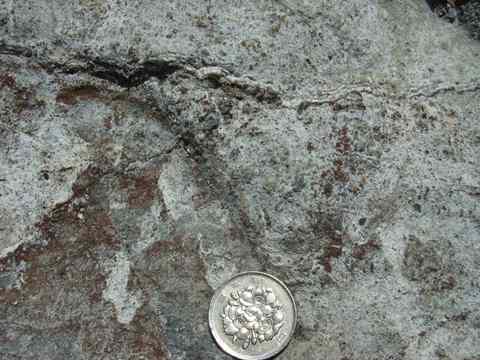Tatarazawa
Shimo-Hino, Fujioka city, Gunma pref., Japan
"No Trespassing" sign was erected. A permission is needed to observe minerals.
Occurrence
Hydrothermal deposit along fault
Minerals formed by low temperature hydrothermal fluid associated with the boundary fault between high-P type Sanbagawa metamorphic rocks and arkose sandstone of Ushibuse Formation, Tomioka Group. This fault is possibly a part of the Median Techtonic Line.

Outcrop of arkose sandstone of tUshibuse Formation. The grayish-white host is arkose sandstone subjected to low temperature metasomatism. The white veins are dolomite associated with dawsonite, alumohydrocalcite, and nordstrandite. The translucent white parts at the center of the vein is dolomite, and the opaque white parts at the boundary between sandstone and the vein are dawsonite. The brown grains in the arkose sandstone are siderite.
Reported Minerals
- Dawsonite
- Alumohydrocalcite
- Nordstrandite
- Dolomite
- Siderite
- Pyrite
Mineral Assemblages
- Dolomite - Dawsonite - Alumohydrocalcite
- Dolomite - Siderite
Localities
- Ichino River (Fault, Chalcedony)
- Tatarazawa (Median Tectonic Line, Dawsonite)
- Niu (Median Tectonic Line, Dawsonite)
- Hitodo (Kannawa Fault, Glauconite)